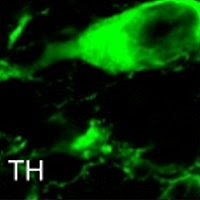We have a potent offering of
5HT-Serotonin Antibodies. This is confirmed by our growing parade of
customer publications referencing their use.
We are pleased to present a new publication referencing use of our
5HT (Serotonin) 2A Receptor Antibody. Dr. Stephen S G Ferguson and team have discovered a link between CFR1 and 5-HT2A Receptor expression:
Ana C Magalhaes,Kevin D Holmes,Lianne B Dale,Laetitia Comps-Agrar,Dennis Lee,Prem N Yadav, Linsay Drysdale, Michael O Poulter, Bryan L Roth, Jean-Philippe Pin, Hymie Anisman& Stephen S G Ferguson. CRF receptor 1 regulates anxiety behavior via sensitization of 5-HT2 receptor signaling. Nature Neuroscience. doi:10.1038/nn.2529. Published online11 April 2010.
Abstract: Stress and anxiety disorders are risk factors for depression and these behaviors are modulated by corticotrophin-releasing factor receptor 1 (CRFR1) and serotonin receptor (5-HT2R). However, the potential behavioral and cellular interaction between these two receptors is unclear. We found that pre-administration of corticotrophin-releasing factor (CRF) into the prefrontal cortex of mice enhanced 5-HT2R–mediated anxiety behaviors in response to 2,5-dimethoxy-4-iodoamphetamine. In both heterologous cell cultures and mouse cortical neurons, activation of CRFR1 also enhanced 5-HT2 receptor–mediated inositol phosphate formation. CRFR1-mediated increases in 5-HT2R signaling were dependent on receptor internalization and receptor recycling via rapid recycling endosomes, resulting in increased expression of 5-HT2R on the cell surface. Sensitization of 5-HT2R signaling by CRFR1 required intact PDZ domain–binding motifs at the end of the C-terminal tails of both receptor types. These data suggest a mechanism by which CRF, a peptide known to be released by stress, enhances anxiety-related behavior via  sensitization of 5-HT2R signaling.
sensitization of 5-HT2R signaling.
Images: (a) Dose response curves for 5-HT–stimulated inositol phosphate formation in HEK 293 cells transfected with FLAG–5-HT2AR and HA-CRFR1 and pretreated with or without 500 nM CRF for 30 min in the presence of dominant-negative dynamin I-K44A. The dose response curves represent the mean ± s.e.m. for four independent experiments. (b,c) Representative laser-scanning confocal micrographs showing the distribution of FLAG-5-HT2AR and HA-CRFR1 (b) and FLAG-5-HT2CR and HA-CRFR1 (c) in HEK 293 cells labeled with FLAG and HA antibodies at 4 °C and then warmed to 37 °C for 30 min in the absence of agonist. (d) Representative laser-scanning confocal micrographs showing the distribution of FLAG–5-HT2AR and HA-CRFR1 labeled with FLAG and HA antibodies at 4 °C and warmed to 37 °C for 30 min in the absence of agonist. (e) Representative laser-scanning confocal micrographs showing the distribution of FLAG–5-HT2AR and HA-CRFR1 transfected into rat cortical neurons labeled with FLAG and HA antibodies at 4 °C and treated with 500 nM CRF and warmed to 37 °C for 30 min. (f) Representative laser-scanning confocal micrographs showing the distribution of FLAG–5-HT2AR and HA-β2AR transfected into HEK 293 cells labeled with FLAG and HA antibodies at 4 °C and treated with 100 μM isoproterenol and warmed to 37 °C for 30 min. Micrographs are representative images of multiple cells imaged on three independent occasions. Scale bars represent 10 μm.
Related Reagents:
All 5HT-Serotonin Antibodies
Neurotransmission Research Antiboodies
Primary Neurons and Astrocytes
-Primary human, rat and mouse neurons and astrocytes
 A431 cells, treated with predetermined IC50
A431 cells, treated with predetermined IC50
 sensitization of 5-HT2R signaling.
sensitization of 5-HT2R signaling.


